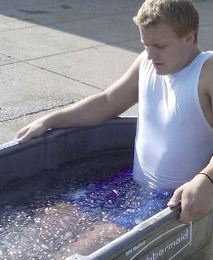Immersion in an ice-water bath is the best way to treat athletes suffering exertional heat stroke say heat illness experts and according to the American Academy of Pediatrics.
Ice-water or cold-water immersion is best for treating athletes suffering hyperthermia caused by physical exertion or exertional heat stroke (EHS) and should be the "definitive treatment," according to a report I co-authored which appeared in the February 2009 issue of the Journal of Athletic Training. EHS has had a 100% survival rate when immediate cooling via cold water immersion or aggressive whole body cold water dousing is started within 10 minutes of collapse.
When ice-water or cold-water immersion are not feasible, the National Association of Athletic Trainers (NATA) says immediate and continual dousing of the patient with water (either from a hose or multiple water containers) combined with fanning and continually rotating cold, wet towels represents a viable on-site alternative until immersive cooling can occur.
"To prevent possible serious consequences or fatalities, athletic trainers are called on to assess, and appropriately care for, individuals who are experiencing heat illnesses," said Brendon McDermott, MS, ATC, instructor, athletic training education program, University of Connecticut, and lead author of an article in the Journal of Athletic Training. "Our review of treatment options helps ensure athletic trainers and other health care professionals understand the most effective methods to care for people who become overheated as they exercise."
The most serious heat-related illness is exertional heat stroke (EHS), which is a condition marked by an elevated core body temperature (≥ 104°F or 40°C) and central nervous system dysfunction.
The next most serious illness, exertional heat exhaustion, is diagnosed when an individual exhibits a moderately elevated core body temperature (generally less than 104°F or 40°C) and is unable to continue exercising. Exertional heat stroke can develop if heat exhaustion is managed improperly; however, heat exhaustion does not necessarily precipitate EHS.
Practical recommendations
Based on the available research, the authors made the following practical recommendations:
- Cooling first and transport second should be the rule, first and foremost.
- Include cold-water immersion, if possible, when setting up a plan for treating exertional heat stroke.
- Ice in coolers adjacent to tubs filled with water should be available for rapid cooling of athletes suffering from EHS.
- In areas where cold-water tubs are impractical, athletic trainers should plan to have a cooler available containing ice, water and towels.
- The cold, wet towels should be changed every two to three minutes as a means of reducing body temperature.
- Alternatively, a large water supply should be available for the continual dousing of a patient (either from a hose or multiple water containers).
- In extreme cases, when individuals may complete training runs at remote locations and EHS is suspected, cooling should be implemented as soon as possible using a water source of some sort (e.g., garden hose, stream, lake, pond).
"The longer a person's body remains above a critical temperature, the more chance there is that serious injury or death can occur," McDermott said. "As our research suggests, patients should always be cooled first at the scene, before being transported to a hospital, clinic or emergency room."
Other treatment options
Among less effective treatment options are:
- fanning the body;
- wet-towel application to the thorax (the part of the body between the neck and the diaphragm) and abdomen;
- ice-pack application to neck, groin and armpits; and
- showering the body with water combined with fanning.
AAP endorsement
In a 2011 Policy Statement,1 the American Academy of Pediatrics identifies the use of cold- or ice-water immersion as the "preferred, most effective method" for prompt, on-site, whole body rapid cooling, and, if unavailable, employing the other, less effective treatment options listed above.
1. Bergeron MF, Rice SG, DiLaura Devore C & Council on Sports Medicine and Fitness and Council on School Health. Policy Statement - Climactic Heat Stress and Exercising Children and Adolescents. Pediatrics 2011; 128(3) (published on line August 8, 2011).








